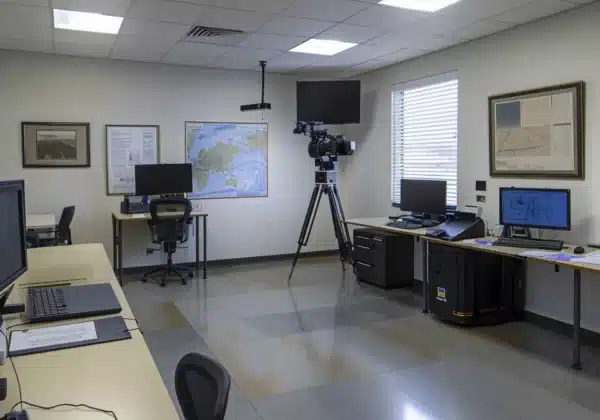Drones and Traditional Methods in Land Surveying: A Comparison
Have you ever questioned whether drones offer better performance than traditional surveying methods? This article compares the accuracy and cost implications of land surveying using drones versus conventional techniques. It also discusses time efficiency and regulatory matters to help readers make informed decisions. The reader will learn how each method addresses common challenges in surveying projects and gains insights crucial for planning future work.
Key Takeaways: Drones vs. Traditional Land Surveying
- drone surveys offer low error margins and automated processing for high-precision mapping
- traditional methods provide reliable data through consistent, manual measurements in complex environments
- software integration streamlines field operations and improves communication between teams
- regulatory compliance ensures safe, standardized drone operations and effective survey practices
- hybrid approaches combine modern and traditional methods for cost-effective, dependable land surveys
Evaluate the Accuracy of Drones Versus Traditional Methods

Drones capture precise land data, producing high-quality digital elevation models with optimal speed and angle. Traditional surveying techniques deliver valid results, yet error margins vary. Software integration increases efficiency, while case studies underscore accuracy differences. Evaluating factors that influence survey accuracy provides valuable insights for a wise investment in reliable land data.
Understand How Drones Capture Precise Land Data
Drones capture detailed land data by employing advanced sensors that deliver high image resolution, ensuring each survey produces clear, accurate visuals. The system often integrates a global positioning system to support precise mapping, while adherence to federal aviation administration standards guarantees the reliability of flight operations, a topic regularly discussed in industry newsletters.
Operational strategy for drone surveys focuses on minimizing errors through precise flight paths and sophisticated data processing techniques. Professionals in engineering adopt this method to generate accurate digital terrain models, and practical insights shared in newsletters help guide firms on integrating drone technology with traditional land surveying practices.
Assess the Effectiveness of Traditional Surveying Techniques
Traditional surveying techniques rely on physical measurements and well-established equipment, such as vehicles equipped with advanced instruments, to gather data that support a streamlined workflow in engineering projects. This resource-intensive approach continues to yield reliable results when creating detailed topographic maps that inform site design and planning.
Seasoned professionals in engineering value traditional methods for their proven accuracy and straightforward processes. They integrate these techniques to produce data that not only guide efficient design but also serve as a dependable foundation in validating and enhancing digital survey results.
Compare Error Margins in Drones and Land Surveys
Engineers observe that error margins in drone surveys are generally lower thanks to advanced sensors and automated data processing, which contribute significantly to precise topography and aerial photography. This technology also allows for the accurate calculation of volume, supporting sustainable energy projects with reliable data on site elevations.
Traditional land surveys, while dependable, may experience slight deviations due to manual measurements and equipment limitations, affecting the consistency of photography results. Professionals often use these methods alongside modern techniques to verify topography details, ensuring that sustainable energy initiatives benefit from comprehensive data validation.
Explore Software Integration With Drone Technology
Software integration plays a crucial role in connecting drone data with a geographic information system, thereby improving communication between field teams and engineers. The integration process supports effective advertising of project capabilities across regions including Africa, while providing energy projects with accurate terrain data.
Professional firms rely on advanced software to merge drone-collected data with established databases, resulting in fast, error-checked outputs. This method benefits various sectors, including energy, by facilitating detailed communication and streamlined project management for reliable land survey measurements.
Analyze Case Studies Highlighting Accuracy Differences
The case studies reveal how both techniques capture a clear photograph of land features while offering unique perspectives on error margins and reliability. Each method is measured against factors such as project health, equipment calibration, and even tree-line detection, ensuring that every claim adheres to the law and industry standards.
One study compared survey outputs to determine variations in precision and found that modern techniques produce stable results when coupled with traditional methods to create a comprehensive perspective:
The insights gained from these comparisons help practitioners adjust practices that benefit overall project health while maintaining adherence to law and ensuring accurate tree mapping.
Discuss Factors Influencing Survey Accuracy
Survey accuracy depends on many factors such as sensor calibration, environmental conditions, and precise planning. Detailed data collection and software like ArcGIS apply practical insights that help professionals manage elevation challenges while supporting sustainability in engineering projects.
Technical considerations involve coordinated flight paths, equipment calibration, and integration of data collection systems to verify land details:
- Precise sensor calibration
- Coordinated flight paths
- Accurate ArcGIS integration
- Reliable elevation data
- Sustainability considerations
Analyze Cost Implications of Drones and Traditional Surveying

This section reviews startup costs for aircraft-based drone surveying and evaluates ongoing expenses of traditional land surveying. It compares long-term costs, examines savings through processing software, and discusses pricing models for surveying services, including potential financial incentives. The analysis also considers tourism projects and reputation impacts, providing practical insights for cost-effective, reliable land surveying solutions.
Break Down Startup Costs for Drone Surveying Technology
Startup costs for drone surveying technology include the expense of acquiring an agricultural drone equipped with high-resolution imaging and point cloud capabilities that capture detailed land features. Investment in this technology provides improved accessibility to diverse terrains and nature features, facilitating precise data collection with reduced reliance on manual methods.
Initial expenditures also cover software for data processing and potential outsourcing of calibration services to ensure accuracy. Investing early in reliable drone systems offers practical benefits for engineering projects, where advanced point cloud models and efficient data integration improve overall survey outcomes.
Evaluate Ongoing Expenses of Traditional Land Surveying
Traditional land surveying incurs ongoing expenses such as equipment maintenance, field labor, and periodic calibration that affect accurate site planning and ecosystem analysis. An engineer often notes that these expenditures necessitate a thorough understanding of water measurement techniques and environmental factors to achieve reliable results.
Regular operating costs involve specialized personnel, updated technology, and adherence to regulatory standards that support effective land assessments. Practitioners observe that a balanced approach to financial planning ensures that survey data remains integral for site planning and ecosystem management while maintaining essential water resource evaluations.
Compare the Long-Term Costs of Both Methods
Engineering firms note that long-term costs favor the integration of both methods as property management and project planning benefit from budget-friendly solutions; remote sensing combined with satellite imagery provides sustained data accuracy while reducing recurring expenses over time. Recent trends during the march toward digital transformation demonstrate that hybrid approaches streamline operations and lessen overall investment.
Industry professionals observe that incorporating drone technology with traditional techniques offers reliable data collection, crucial for property assessments and project management. The sustained use of remote sensing and satellite data reinforces the value provided by these methods, bridging the gap between upfront investments and long-term operational savings.
Assess Savings Achieved Through Drone Implementations
The use of dji technology in drone surveying reduces field time by automating data capture, resulting in significant cost savings for projects involving floodplain assessments and urban planning. This approach in civilian engineering projects cuts down on manual labor and increases precision, making it a practical option for engineering firms.
By integrating automation, drone implementations offer quick and reliable data processing that supports civil engineering tasks and urban planning initiatives. Professionals appreciate how enhanced accuracy in floodplain mapping provided by drones translates to reduced operational expenses and improved project outcomes.
Discuss Pricing Models for Hiring Surveying Services
The pricing models for hiring surveying services vary based on project location and technology, with some providers offering package rates for projects in urban area and road inspections. This approach allows clients to choose services that include virtual reality presentations and enhanced image precision to ensure safety at the worksite:
The discussion of pricing models reflects industry expertise and practical insights, offering guidance for selecting a service that meets budget constraints while addressing safety concerns and delivering high-quality images. Professionals find that a balanced review of cost structures and technology benefits aids in crafting a tailored solution for each project need.
Explore Potential Financial Incentives for Using Drones
The use of drones in surveying can lead to financial benefits when considering the cost of updating equipment, reducing labor, and using modern surveying software to analyze terrain data accurately. This method helps address challenges in zoning and regulatory compliance while lowering overall expenses compared to traditional approaches, offering a practical solution for engineering projects.
Industry experts note that drone technology supports cost savings by streamlining approaches to plant layout inspections and terrain evaluations. This solution minimizes repetitive manual tasks and ensures reliable reporting on zoning projects, paving the way for more efficient, budget-friendly land surveying outcomes.
Investigate Time Efficiency of Surveying With Drones

The discussion compares the speed of data collection using advanced drones to fieldwork by traditional survey crews. It outlines project turnaround times, improved workflows with streamlined flight plans, and efficient post-processing of soil measurements using industry statistics. This overview also examines marketing implications of reduced field time, setting the stage for detailed analysis of each aspect.
Assess the Speed of Data Collection Using Drones
Drones streamline data collection by rapidly capturing high-resolution images, resulting in precise pixel measurements and quick mapping of features such as a river. Their fast processing capabilities significantly reduce the cost and labor compared to using a total station for similar tasks.
Rapid image capture by drones supports swift evaluations of irrigation systems and other infrastructural elements without delays. This method provides practical insights, demonstrating how technology offers efficient solutions for precise land surveying projects.
Compare Fieldwork Time With Traditional Survey Crews
Field crews in traditional land surveying require extended periods to navigate diverse terrains, especially when assessing areas like a dense forest or complex infrastructure, resulting in increased work hours compared to unmanned aerial vehicles. Modern drones regard natural environment challenges with quick data capture in controlled airspace, offering a clear advantage in speed and accuracy.
Survey teams using traditional techniques often face delays when physically covering large or difficult-to-access areas, particularly when mapping varied infrastructure in urban or rural landscapes. In contrast, unmanned aerial vehicles significantly reduce fieldwork time, ensuring rapid and precise data capture even in robust natural environments or over challenging airspace.
Analyze Project Turnaround Times for Both Methods
Project turnaround times benefit greatly from drone technology, as the system streamlines the kinematics of surveys, integrating data directly into building information modeling systems. Rapid computer processing minimizes delays seen in traditional methods, providing practical insights for agriculture and engineering projects that require timely, accurate information:
- Advanced flight planning reduces on-site time
- Automated data processing improves speed
- Integration with building information modeling accelerates reporting
In contrast, conventional surveying methods often require extended fieldwork, resulting in slower data integration and longer project completion times. Engineering professionals note that combining drone surveys with traditional techniques can support efficient project planning and deliver consistent information that meets the timeliness demands of agriculture and construction sectors.
Evaluate Workflow Improvements With Drone Technology
Drone technology improves workflow by enhancing data usability and reducing time spent on integrating ground control points; professionals cite a streamlined process that ensures consent for data use and rapid cloud storage, particularly when surveying challenging mountain terrain:
Industry experts report that drone systems boost operational efficiency through automated processes and real-time cloud updates, cutting down manual verification and ensuring timely consent protocols. This approach offers practical solutions for projects spanning expansive mountain regions and diverse landscapes, supporting consistent short-term and long-term planning.
Review Time Spent on Post-Processing Data
The review of time spent on post-processing data demonstrates that drone surveys reduce operational delays significantly through quick integration of artificial intelligence. Industry experts note that quicker results help optimize budget allocation and provide better navigation options, ensuring a smooth process under various environmental conditions.
Engineering professionals value streamlined workflows that allow for rapid data post-processing when managing insurance claims and project estimates. This efficient approach minimizes manual adjustments and supports accurate reporting, giving stakeholders a reliable method to handle challenges in diverse work environments.
Highlight Time-Saving Features of Advanced Drones
Advanced drones save time by efficiently capturing detailed land data while reducing risk during surveys. These systems use lidar, georeferencing, and altitude measurements to quickly assess vegetation and topography, offering reliable insights that support streamlined project planning:
Engineers appreciate the time-saving benefits of these drones as they reduce the duration of fieldwork and simplify data integration. The clear readings from lidar and georeferencing simplify decisions, minimize manual adjustments, and support efficient project management while keeping survey risks low.
Examine Regulatory Considerations for Drone Usage

Regulatory issues for drone usage cover permissions, compliance challenges, liability, and best practices. Experts assess how aviation authorities shape rules impacting land surveying choices. Key areas include data processing, laser scanning, photogrammetry, software integration, and robotics to ensure legal operations and safe practices.
Recognize Drone Regulations Set by Aviation Authorities
Regulatory authorities set clear guidelines to help maintain accuracy and precision in drone operations when used as a tool in topographic surveys and inspections, ensuring that every flight meets industry standards. Strict rules require adherence to specified wavelength ranges and approved inspection procedures to support safe and effective mapping techniques.
By following established drone regulations, engineering professionals achieve consistent results and minimize risks during land surveys, making the process reliable for both traditional and digital methods:
- Compliance with aviation guidelines
- Regular calibration for accuracy and precision
- Adherence to approved wavelength settings
- Thorough pre-flight inspections
Each regulation lets experts perform precise topographic surveys and efficient inspection, ensuring dependable data collection on every project.
Assess Permissions Required for Drone Land Surveying
Professionals in land surveying emphasize that obtaining the necessary permissions for drone operations requires careful adherence to federal rules and local ordinances, ensuring smooth data acquisition and development of projects. Regulatory bodies often require clear documentation when using models such as the dji phantom for cartography tasks, supported by detailed flight plans and approval certificates:
Engineering professionals recommend maintaining accurate records to facilitate the approval process and ensure compliance with cartography standards during project development. This approach not only improves regulatory transparency but also assists in managing the density of data acquisition for effective land surveying outcomes.
Explore Challenges of Compliance With Traditional Methods
Traditional surveying practices often struggle with regulatory compliance, and experts note that manual methods require extra steps to verify data and ensure alignment with local ordinances; this impacts productivity and demands close attention to altanspsfaqs guidelines while managing crop-related assessments. Here is a list of factors that professionals address in these compliance challenges:
- Strict documentation requirements
- Manual calibration methods
- Extended verification times
Engineering professionals emphasize that technology integration in surveys must account for traditional limitations, leading to additional review processes that affect productivity and overall project timelines. They provide actionable insights on combining modern strategies with established practices to meet regulatory standards while efficiently managing crop evaluations and other field surveys.
Discuss Liability and Insurance Implications for Drones
Experts note that liability and insurance considerations for drones require clear policies that cover risks such as flood damage, slope instability, and habitat disruption, ensuring that surveying innovation remains secure. These guidelines help firms maintain operational integrity and guarantee that all potential hazards are managed effectively:
Industry specialists advise that maintaining robust insurance policies strengthens risk management for drone operations in surveying, making it easier to resolve unforeseen complications. Applying these measures ensures that drones continue to support engineering tasks with confidence, backed by comprehensive liability and insurance plans.
Review Best Practices for Legal Drone Operation
Engineering professionals advise that adhering to legal guidelines in drone operation begins with regular maintenance checks and verifying payload limits to ensure safe flights for accurate data collection. Strict precautions, such as confirming equipment shape and calibration with a tape measure, support dependable survey outcomes.
Experts recommend practical steps for legal operations that include thorough equipment checks, regulatory compliance reviews, and routine maintenance schedules to secure optimal drone performance and reliable data. The following steps outline best practices for legal drone operation:
- Conduct regular maintenance using a tape measure and calibrated instruments.
- Verify that the drone’s payload and shape meet specified regulatory limits.
- Review and update data protocols to align with legal standards.
Analyze the Impact of Regulation on Surveying Choices
Regulatory standards shape surveying choices by demanding strict sensor calibration and adherence to approved operational procedures. Engineering professionals using dji mavic drones for construction site assessments and grading operations report that these measures enhance data accuracy and project reliability.
Clear regulations foster a blend of traditional practices with modern technology, guiding firms toward efficient surveying methods. By enforcing standards on sensor functionality and data collection, regulatory guidelines ensure that construction, site grading, and mapping tasks achieve the precision required for successful execution.
Highlight Applications for Drones in Land Surveying

Drones offer swift aerial survey benefits in topographic surveys and construction site analysis, while environmental assessments and agricultural land mapping support sustainable design. Designers, mining experts, and urban planners harness drone data to improve landscape studies and wind monitoring. This overview sets the stage for specific insights on multiple innovative drone applications.
Explore How Drones Aid in Topographic Surveys
Drones offer significant benefits in topographic surveys by capturing high-resolution imagery over large areas, including expansive acres of terrain. ludlow engineers have observed that the integration of advanced sensors enhances data quality, resulting in precise mapping outputs that serve as a reliable deliverable for site assessments and erosion monitoring.
Experts note that drone technology streamlines the collection of geospatial data, reducing manual measurement errors and accelerating reporting timelines. By providing clear, accurate outputs, the method enables professionals to address issues like erosion more efficiently while ensuring that each deliverable meets the stringent requirements of engineering projects.
Discuss the Role of Drones in Construction Site Analysis
Experts in engineering observe that drones offer substantial benefits for construction site analysis by providing rapid aerial views and detailed site data. These systems deliver critical information that supports project planning and allows for efficient environmental monitoring during each phase.
Professionals integrate drone data into construction workflows to boost overall precision and enhance safety measures on site. This modern approach delivers actionable insights and serves as a vital tool for assessing work conditions and monitoring environmental aspects throughout the project lifecycle.
Review Drone Usage in Environmental Assessments
Engineers regularly review drone usage in environmental assessments to capture detailed terrain data and monitor site conditions accurately, offering a practical solution to survey challenges. They use advanced imaging systems to collect reliable visual data, which supports improved evaluation of changes in land use and vegetation health:
Surveying professionals integrate drone data into environmental assessment protocols to ensure timely and accurate reporting on site changes. Their practical application of drone technology helps address key issues in environmental management, reducing project delays and supporting effective land planning initiatives.
Assess Applications in Agricultural Land Mapping
Advanced drones provide practical solutions for mapping large agricultural areas with precision. Their ability to capture high-resolution images and analyze soil and crop conditions in real time offers a significant advantage in managing expansive farmlands:
Consulting engineers advise that the adoption of drone technology enhances the ability to monitor field conditions regularly while minimizing operational downtimes. Integrating drone-collected data with existing GIS systems offers actionable insights that help optimize resource allocation and boost agricultural productivity.
Highlight Survey Enhancements in Urban Planning
Drones significantly improve surveying in urban planning by capturing precise aerial images, which are then integrated with geographic data to optimize city layout and infrastructure planning. This modern approach reduces manual survey errors and supports informed decision-making through automated data analysis:
- High-resolution aerial imagery
- Automated integration with GIS systems
- Accurate mapping of urban features
Engineering firms find that using drone technology in urban terrain assessments leads to faster data collection and clearer visualizations for city development projects. Such methods address common challenges in urban planning by providing detailed and reliable information for improving roadway layouts and public utilities management.
Examine Other Innovative Uses for Drone Technology
Drone technology extends its value beyond traditional mapping by offering unique applications such as infrastructure inspections, environmental monitoring, and utility mapping:
Engineering professionals utilize drone technology to gather real-time data that directly enhances project planning and decision-making. The integration of innovative drone applications addresses common challenges in land surveying by reducing manual efforts and improving data accuracy for various engineering projects.
Understand User Experience With Drones and Traditional Techniques

Gather insights from professionals using drones while evaluating user feedback on traditional surveying methods. This section compares training requirements, examines user comfort in method selection, reviews common challenges, and assesses technological acceptance among surveying teams, all to inform choices and improve project outcomes.
Gather Insights From Professionals Using Drones
Experts in engineering report that drone technology significantly improves data collection and project efficiency. They note that using drones simplifies aerial mapping and reduces fieldwork time, which makes land surveying more precise and cost-effective.
Industry professionals share that drones deliver clear, reliable data that supports decision-making in construction and environmental projects. Their hands-on experience confirms that adopting drone technology has streamlined workflows and improved data accuracy for challenging site evaluations.
Evaluate User Feedback on Traditional Surveying Methods
Industry professionals note that feedback on traditional surveying methods highlights reliability in capturing accurate land measurements, even in complex environments. Users emphasize that these techniques offer a familiar approach with consistent results, making them a trusted option for projects that require dependable data.
Practitioners report that traditional methods work effectively for detailed topographic mapping and site planning, with many appreciating the straightforward operation and ease of verification. Feedback also indicates that while these methods may require more time in the field, professionals find the results dependable for engineering projects and long-term planning considerations.
Compare Training Requirements for Each Approach
Engineers note that training programs for drone usage are typically shorter and more focused on technology operations, software calibration, and safety protocols, making them easier to adopt for teams aiming to reduce fieldwork time. Companies in the surveying sector benefit from hands-on sessions that address practical challenges, resulting in quick adaptation and improved project efficiency.
Traditional surveying methods require an extensive learning period that covers manual measurement techniques, equipment handling, and regulatory adherence, which can be demanding for new staff. Surveying professionals often experience a steeper learning curve in these methods, highlighting the benefits of hybrid training approaches that integrate both modern and conventional techniques to suit diverse project needs.
Discuss How User Comfort Affects Method Choice
User comfort plays a key role in choosing between drone technology and traditional surveying methods. Professionals often note that operators with prior experience in modern tools adapt quickly to drone interfaces, while many teams value the hands-on approach of conventional techniques for their familiar workflow.
The ease of learning and operational simplicity influences decision-making in land surveying projects. Experts report that user comfort leads to improved productivity and higher data quality, as operators tend to prefer techniques that match their training and previous experiences.
Review Common Challenges Faced by Surveyors
Surveying professionals face technical difficulties with both drone technology and traditional techniques. Drone operations can encounter challenges such as unpredictable weather conditions and equipment malfunctions, while traditional methods often suffer from prolonged fieldwork and calibration inconsistencies that affect data precision.
Practitioners note that adapting to evolving regulations and integrating new software also presents obstacles in each method. These challenges require ongoing training and diligent maintenance practices to ensure reliable, accurate land surveying outcomes for construction, agricultural, and environmental projects.
Assess Technological Acceptance Among Surveying Teams
Surveying teams show increasing trust in advanced drone technology, with many experts reporting a smooth transition in operations. They appreciate the efficiency and clarity provided by automated processes, which cut down on time and boost confidence in data accuracy.
Engineering professionals have observed that technological acceptance is growing steadily due to hands-on training efforts and improved software integration. This growth is evident in the following factors that drive team adoption and support a balanced survey approach:
- Comprehensive training sessions
- Improved user interfaces
- Proven reliability in data output
Conclusion
Drones and conventional surveying methods each offer distinct benefits for land data collection, with drones boosting efficiency through automated data capture and traditional methods ensuring reliability through well-established processes. Engineering professionals integrate both approaches to maximize accuracy and balance cost-effectiveness with precision. The combination of modern technology and time-tested practices supports informed decision-making in critical projects across construction, agriculture, and environmental assessments. This comparison underscores the need for a tailored approach that leverages the strengths of both methods to achieve comprehensive, dependable land surveying outcomes.



